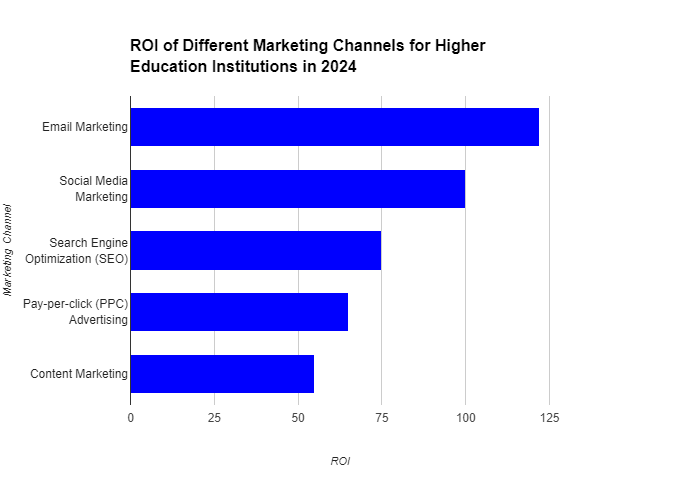Higher Education Marketing in 2024 reflects dynamic shifts with key data points guiding strategic adaptations. The industry responds to enrollment challenges through data-driven approaches, emphasizing digital dominance, authenticity, and diversity. Global spending projections of $76.9 billion by 2025 highlight a commitment to innovative marketing strategies.

Picture this: a crisp autumn afternoon, sun dappling through leaves as eager high schoolers, eyes glittering with hope, flood a college campus tour.
Pamphlets clutched like talismans, they peer at ivy-covered walls and nervously giggle at jokes by tour guides in tweed jackets. This, for generations, has been the image of higher education marketing – glossy brochures, campus visits, and maybe a billboard overlooking the interstate. But here’s the secret whispered amidst the rustling leaves: it’s no longer working.
The admissions landscape has shifted, not with the subtlety of a changing season, but with the force of a viral earthquake. Today’s prospective students have smartphones surgically grafted to their palms, their thumbs scrolling through a kaleidoscope of possibilities before breakfast. Their attention spans, honed by TikTok dances and Instagram stories, measure in milliseconds, not minutes. The brochure won’t cut it.
This is where New Age Marketing, a potent blend of digital wizardry and strategic PR, rises like a phoenix from the ashes of brochures and billboards.

It’s about meeting students where they live – on social media, in YouTube playlists, on Twitch streams. It’s about crafting stories that resonate, not just regurgitating facts. It’s about authenticity, transparency, and building genuine connections in a digital world.
Here’s the hard truth: a study by Pew Research Center found that only 14% of students rely on college brochures for information. Meanwhile, a whopping 84% use social media to research colleges. Let that sink in. It’s not simply about changing platforms; it’s about rewiring the entire marketing mindset.
Think beyond Facebook ads and generic Instagram posts. Craft compelling TikTok explainers highlighting the quirks of your campus squirrels or the secret pizza dungeon in the library.
Partner with student influencers who can showcase the vibrant tapestry of campus life – the late-night study sessions fueled by ramen, the impromptu dance parties in dorm hallways, the passionate debates in student government meetings. These are the moments that make your institution real, relatable, and irresistible.

PR, too, gets a makeover. Ditch the press releases touting your Nobel laureate (we all know about them already). Instead, pitch stories about the student who built a robot dog from recycled parts or the professor who’s teaching Shakespeare through rap battles. These are the narratives that capture headlines, spark conversations, and make your institution stand out from the crowd.
But remember, New Age Marketing isn’t just about flashy content. It’s about data-driven insights. Track your analytics, understand your audience, and personalize your message. No more shotgun blasts of information; each student deserves a carefully curated experience, just like a bespoke education.
This shift toward digital and PR isn’t a fad; it’s a necessity. A study by QS World University Rankings found that institutions with strong social media engagement see a 23% increase in applications. The ROI is clear – invest in storytelling, build your online community, and watch your admissions office overflow.
Key Trends and Insights in 2024
One of the foremost challenges is the decline in birth rates and evolving student preferences, placing increased pressure on institutions to stand out in a crowded field.

To address these enrollment challenges, the industry is leaning heavily on data-driven strategies, as revealed by a report from Search Influence indicating that 70% of higher education marketers plan to increase digital marketing spending in 2024.
The dominance of digital platforms has become a hallmark of student outreach efforts. With 80% of prospective students initiating their college search online, institutions are investing significantly in websites, social media, and video content to create crucial touchpoints.
The mobile-first optimization has become imperative in this digital era, with over 60% of students using smartphones to research colleges, according to Higher Education Marketing Report.

However, beyond the digital landscape, the importance of authentic storytelling has emerged as a potent tool. Establishing emotional connections with potential students through compelling narratives showcasing faculty expertise, student experiences, and unique campus aspects has become a cornerstone of successful marketing efforts.
The rise of experiential marketing, facilitated by virtual campus tours and interactive content, allows prospective students to virtually step onto campuses, offering immersive experiences that play a crucial role in decision-making. Additionally, focusing on diversity and inclusion has become paramount in resonating with the values of today’s student body.
Embracing new channels like TikTok for targeted outreach, as noted by the Influencer Marketing Hub, underlines the industry’s commitment to staying relevant in the ever-evolving digital landscape. Moreover, an outcome-driven approach is gaining traction, with institutions measuring campaign effectiveness based on metrics such as application rates, enrollment numbers, and student satisfaction.
Recent Data in Higher Education Marketing
A report by Search Influence indicates a significant uptick, with 70% of higher education marketers planning to increase their spending on digital marketing in 2024. This underscores a clear recognition within the industry of the increasing importance of digital platforms in engaging prospective students.

Online college search behavior among prospective students further validates this trend, with a study by Higher Ed Dive revealing that a substantial 80% of students initiate their college search online. This statistic highlights the pivotal role of digital presence and optimization, making it imperative for institutions to prioritize a robust online strategy.
The utilization of video content has emerged as a powerful tool in higher education marketing efforts. According to a survey by Educause, 60% of institutions are leveraging video content to showcase their offerings. This approach not only caters to the preferences of the modern audience but also aligns with the broader trend of visual storytelling.
In response to the changing landscape of social media, TikTok has witnessed growing popularity among the Gen Z audience. Education marketers are increasingly recognizing the potential of this platform, leveraging its reach and engagement to connect with the demographic they aim to attract.

This aligns with broader trends in influencer marketing, where micro-influencers on TikTok are gaining traction for targeted outreach, as highlighted by the Influencer Marketing Hub.
The data also sheds light on the evolving preferences of prospective students, indicating a growing demand for career-focused programs and institutions that provide clear value propositions for employability after graduation.
This resonates with the concerns of students and families about the return on investment in education, emphasizing the need for institutions to articulate and showcase the practical benefits of their programs.
Simultaneously, as enrollment faces challenges, factors contributing to the decline include rising tuition costs, student debt concerns, changing demographics, and alternative education options. This calls for a strategic reevaluation of educational offerings and marketing approaches to address the multifaceted reasons behind the enrollment decline.
Looking Ahead: Future of Higher Education Marketing
The future of Higher Education Marketing landscape is marked by a profound shift influenced by technological advancements, a heightened focus on student success metrics, and an imperative for continuous adaptation to navigate the ever-changing trends in the educational sector.

Technology-driven innovations are poised to play a central role in shaping the marketing strategies of higher education institutions. Artificial intelligence, virtual reality, and personalized learning platforms are emerging as powerful tools to engage and attract prospective students.
These innovations not only enhance the overall student experience but also provide institutions with data-driven insights to tailor marketing campaigns more effectively.
A crucial aspect of the future of Higher Education Marketing is the increased emphasis on student success metrics and career preparedness.
In an era where return on investment is a paramount concern for students and families, marketing efforts will pivot towards highlighting metrics around career outcomes, graduation rates, and alumni success stories. This data-centric approach aligns with the growing demand for programs that directly contribute to employability post-graduation.

The fast-paced evolution of the education landscape necessitates a continuous adaptation from marketing professionals. Agility and responsiveness to changing trends will be vital for institutions to stay relevant and appeal to the preferences of the incoming student cohorts.
This adaptability extends to embracing new technologies, staying attuned to shifts in student demographics, and reevaluating marketing strategies to align with the evolving needs of the target audience.
Deeper Dive into Higher Education Marketing Data
Examining enrollment data reveals a notable trend: U.S. college enrollment has experienced a decline for 12 consecutive years, dropping by 9.4% since 2010, according to the National Center for Education Statistics.
![Higher Education Marketing 2023 and Beyond [Detailed Analysis], Higher Education Marketing, Education Marketing, Education PR, Digital PR, Public Relations, Digital Marketing, social media, SEO for Higher Education, Digital Marketing for Higher Education](https://firdoshkhan.in/wp-content/uploads/2022/11/PPC-Advertising-Online-Marketing.jpg)
This decline is attributed to factors such as rising tuition costs, student debt concerns, changing demographics, and the availability of alternative education options.
Digital marketing insights illuminate the contemporary pathways to student engagement. A significant 72% of prospective students employ social media to research colleges and universities, as reported by E-marketing Strategies for Higher Education. This underscores the pivotal role of a robust online presence and strategic social media usage in reaching and resonating with the target audience.
Financial data sheds light on the investment institutions make in Higher Education Marketing. Budgets are projected to increase by an average of 5.1% in 2024, according to Adage. Understanding these financial dynamics is crucial for institutions seeking to optimize their marketing strategies.
Moreover, data-driven marketing strategies are proving their worth, with a reported 60% improvement in return on investment compared to traditional methods, as per Marketo.
Exploring student preferences and factors influencing college choices offers valuable insights for crafting compelling marketing narratives.

A striking 78% of students value experiential learning opportunities, emphasizing the importance of showcasing hands-on experiences. Additionally, the emphasis on career-focused programs is evident, with students seeking degrees directly linked to employment, aligning with the demand for clear value propositions for post-graduation employability.
Real-world strategies and success stories provide practical benchmarks for effective Higher Education Marketing. Institutions like the University of Florida, Purdue University, and Boston University have demonstrated the impact of data-driven campaigns, award-winning storytelling, and innovative partnerships with student micro-influencers, resulting in increased website traffic, application rates, and program inquiries.
Latest Developments in Education Marketing (2024)
In the landscape of Higher Education Marketing for 2024, the industry is witnessing a series of impactful developments that are reshaping strategies to engage and attract prospective students.

One prominent trend is the emergence of hyper-personalization, where institutions are leveraging advanced technologies to tailor marketing messages and content to individual student needs and interests. This is in line with the contemporary shift away from one-size-fits-all approaches, as highlighted by the latest reports in education marketing.
Micro-influencers are playing a pivotal role in targeted marketing efforts. These smaller, niche influencers with loyal followings are proving to be highly influential, as indicated by the Influencer Marketing Hub, which reports that micro-influencers generate 2X the engagement compared to their macro counterparts.
Collaborating with educators, alumni, and student leaders authentically resonates with specific target audiences, facilitating genuine connections and increasing brand awareness.
There is a noticeable shift in the focus of marketing messages towards career outcomes and return on investment. With students and their families increasingly concerned about the practical value of education, institutions are aligning their narratives to highlight metrics around career preparedness, skills development, and alumni success stories. This emphasis on tangible outcomes contributes to a transparent and compelling value proposition for prospective students.

Short-form video platforms, such as TikTok and Instagram Reels, are capturing attention spans and reshaping content strategies. Engaging video content, including testimonials, campus tours, and snippets of student life, is becoming increasingly crucial for connecting with prospective students on a deeper, more immediate level.
This aligns with the data indicating that 83% of students use social media to research colleges and universities, emphasizing the importance of visual content in the digital era.
In response to broader societal shifts, social impact and diversity have become key differentiators in Higher Education Marketing. Showcasing a commitment to social responsibility, inclusivity, and ethical practices is not just a feel-good add-on; it has become a significant factor in attracting students who value these principles. The Pew Charitable Trusts reports that 74% of Gen Z students consider diversity and inclusion efforts when choosing a college.
![Higher Education Marketing 2023 and Beyond [Detailed Analysis], Higher Education Marketing, Education Marketing, Education PR, Digital PR, Public Relations, Digital Marketing, social media, SEO for Higher Education, Digital Marketing for Higher Education](https://firdoshkhan.in/wp-content/uploads/2022/11/Higher-ED-Marketing-Content.jpg)
Global spending statistics in education marketing are expected to reach $76.9 billion by 2025, according to Statista. This underscores the industry’s recognition of the significance of strategic investments in marketing to remain competitive and innovative.
Additionally, mobile traffic insights reveal that 57% of website traffic for higher education institutions comes from mobile devices, emphasizing the need for mobile optimization in marketing strategies.
As a bonus, the exploration of emerging technologies, such as virtual reality and augmented reality, for immersive campus tours and interactive learning experiences is indicative of the industry’s commitment to staying at the forefront of innovation. Education marketing is becoming increasingly data-driven, with institutions leveraging analytics to track campaign performance and optimize their strategies for maximum impact.
To Conclude
Higher Education Marketing in 2024 reflects dynamic shifts with key data points guiding strategic adaptations. The industry responds to enrollment challenges through data-driven approaches, emphasizing digital dominance, authenticity, and diversity. Global spending projections of $76.9 billion by 2025 highlight a commitment to innovative marketing strategies.
Micro-influencers, career outcomes, and short-form video platforms shape contemporary narratives, while social impact and diversity become pivotal differentiators. The call to action is clear – institutions must adapt and innovate. Hyper-personalization, leveraging micro-influencers, and emphasizing tangible career outcomes are essential strategies.
Acknowledging the ongoing evolution in education marketing underscores the importance of continuous adaptation to emerging technologies and evolving student preferences.
In this rapidly changing landscape, Higher Education Marketing must remain agile, ensuring institutions craft compelling narratives that resonate with prospective students and thrive in the evolving educational terrain.
![Higher Education Marketing 2023 and Beyond [Detailed Analysis], Higher Education Marketing, Education Marketing, Education PR, Digital PR, Public Relations, Digital Marketing, social media, SEO for Higher Education, Digital Marketing for Higher Education](https://firdoshkhan.in/wp-content/uploads/2022/11/Higher-Education-Marketing-300x200.jpg)


Pingback: Marketing the Why in Higher Education
Pingback: Why Marketing Strategy Matters in Higher Education?
Pingback: Why You Need a Higher Education Inbound Marketing Strategy?
Pingback: 4 Best Digital Marketing Strategies for Online Universities
Pingback: How Does Inbound Marketing Benefit Higher Education?
Pingback: Is a Higher Education Marketing Agency the Right Partner for You?
Pingback: Visual Content Strategy for Higher Education
Pingback: Why You Should Partner with A Higher Education Marketing Expert
Pingback: Why Business Schools Need Digital Marketing Expert